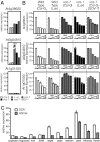Conserved RNaseII domain protein functions in cytoplasmic mRNA decay and suppresses Arabidopsis decapping mutant phenotypes
- PMID: 20798041
- PMCID: PMC2936607
- DOI: 10.1073/pnas.1007060107
Conserved RNaseII domain protein functions in cytoplasmic mRNA decay and suppresses Arabidopsis decapping mutant phenotypes
Abstract
Both transcription and RNA decay are critical for normal gene regulation. Arabidopsis mutants with defects in VARICOSE (VCS), a decapping complex scaffold protein, lack mRNA decapping and 5'-to-3' decay. These mutants show either severe or suppressed phenotypes, depending on the Arabidopsis accession. Here, we show that the molecular basis for this variation is the SUPPRESSOR OF VARICOSE (SOV), a locus that encodes a conserved, cytoplasmically localized RRP44-like RNaseII-domain protein. In vivo RNA decay assays suggest that active forms of this protein carry out decay on mRNA substrates that overlap with those of the decapping complex. Members of this conserved gene family encode proteins lacking the PIN domain, suggesting that SOV is not a functional component of the RNA exosome.
Conflict of interest statement
The authors declare no conflict of interest.
Figures





Similar articles
-
Arabidopsis mRNA decay landscape arises from specialized RNA decay substrates, decapping-mediated feedback, and redundancy.Proc Natl Acad Sci U S A. 2018 Feb 13;115(7):E1485-E1494. doi: 10.1073/pnas.1712312115. Epub 2018 Jan 31. Proc Natl Acad Sci U S A. 2018. PMID: 29386391 Free PMC article.
-
Arabidopsis DCP2, DCP1, and VARICOSE form a decapping complex required for postembryonic development.Plant Cell. 2006 Dec;18(12):3386-98. doi: 10.1105/tpc.106.047605. Epub 2006 Dec 8. Plant Cell. 2006. PMID: 17158604 Free PMC article.
-
Components of the Arabidopsis mRNA decapping complex are required for early seedling development.Plant Cell. 2007 May;19(5):1549-64. doi: 10.1105/tpc.106.047621. Epub 2007 May 18. Plant Cell. 2007. PMID: 17513503 Free PMC article.
-
Functions of the cytoplasmic exosome.Adv Exp Med Biol. 2010;702:79-90. Adv Exp Med Biol. 2010. PMID: 21618876 Review.
-
Beyond transcription factors: roles of mRNA decay in regulating gene expression in plants.F1000Res. 2018 Dec 17;7:F1000 Faculty Rev-1940. doi: 10.12688/f1000research.16203.1. eCollection 2018. F1000Res. 2018. PMID: 30613385 Free PMC article. Review.
Cited by
-
Uridylation and the SKI complex orchestrate the Calvin cycle of photosynthesis through RNA surveillance of TKL1 in Arabidopsis.Proc Natl Acad Sci U S A. 2022 Sep 20;119(38):e2205842119. doi: 10.1073/pnas.2205842119. Epub 2022 Sep 12. Proc Natl Acad Sci U S A. 2022. PMID: 36095196 Free PMC article.
-
Monitoring of XRN4 Targets Reveals the Importance of Cotranslational Decay during Arabidopsis Development.Plant Physiol. 2020 Nov;184(3):1251-1262. doi: 10.1104/pp.20.00942. Epub 2020 Sep 10. Plant Physiol. 2020. PMID: 32913043 Free PMC article.
-
In the absence of BYPASS1-related gene function, the bps signal disrupts embryogenesis by an auxin-independent mechanism.Development. 2012 Feb;139(4):805-15. doi: 10.1242/dev.077313. Development. 2012. PMID: 22274700 Free PMC article.
-
Catalytic activities, molecular connections, and biological functions of plant RNA exosome complexes.Plant Cell. 2022 Mar 4;34(3):967-988. doi: 10.1093/plcell/koab310. Plant Cell. 2022. PMID: 34954803 Free PMC article. Review.
-
Arabidopsis mRNA decay landscape arises from specialized RNA decay substrates, decapping-mediated feedback, and redundancy.Proc Natl Acad Sci U S A. 2018 Feb 13;115(7):E1485-E1494. doi: 10.1073/pnas.1712312115. Epub 2018 Jan 31. Proc Natl Acad Sci U S A. 2018. PMID: 29386391 Free PMC article.
References
-
- Garneau NL, Wilusz J, Wilusz CJ. The highways and byways of mRNA decay. Nat Rev Mol Cell Biol. 2007;8:113–126. - PubMed
-
- Belostotsky DA, Sieburth LE. Kill the messenger: mRNA decay and plant development. Curr Opin Plant Biol. 2009;12:96–102. - PubMed
-
- Wilusz CJ, Wilusz J. Bringing the role of mRNA decay in the control of gene expression into focus. Trends Genet. 2004;20:491–497. - PubMed
-
- Decker CJ, Parker R. A turnover pathway for both stable and unstable mRNAs in yeast: Evidence for a requirement for deadenylation. Genes Dev. 1993;7:1632–1643. - PubMed
Publication types
MeSH terms
Substances
LinkOut - more resources
Full Text Sources
Other Literature Sources
Molecular Biology Databases
Research Materials

